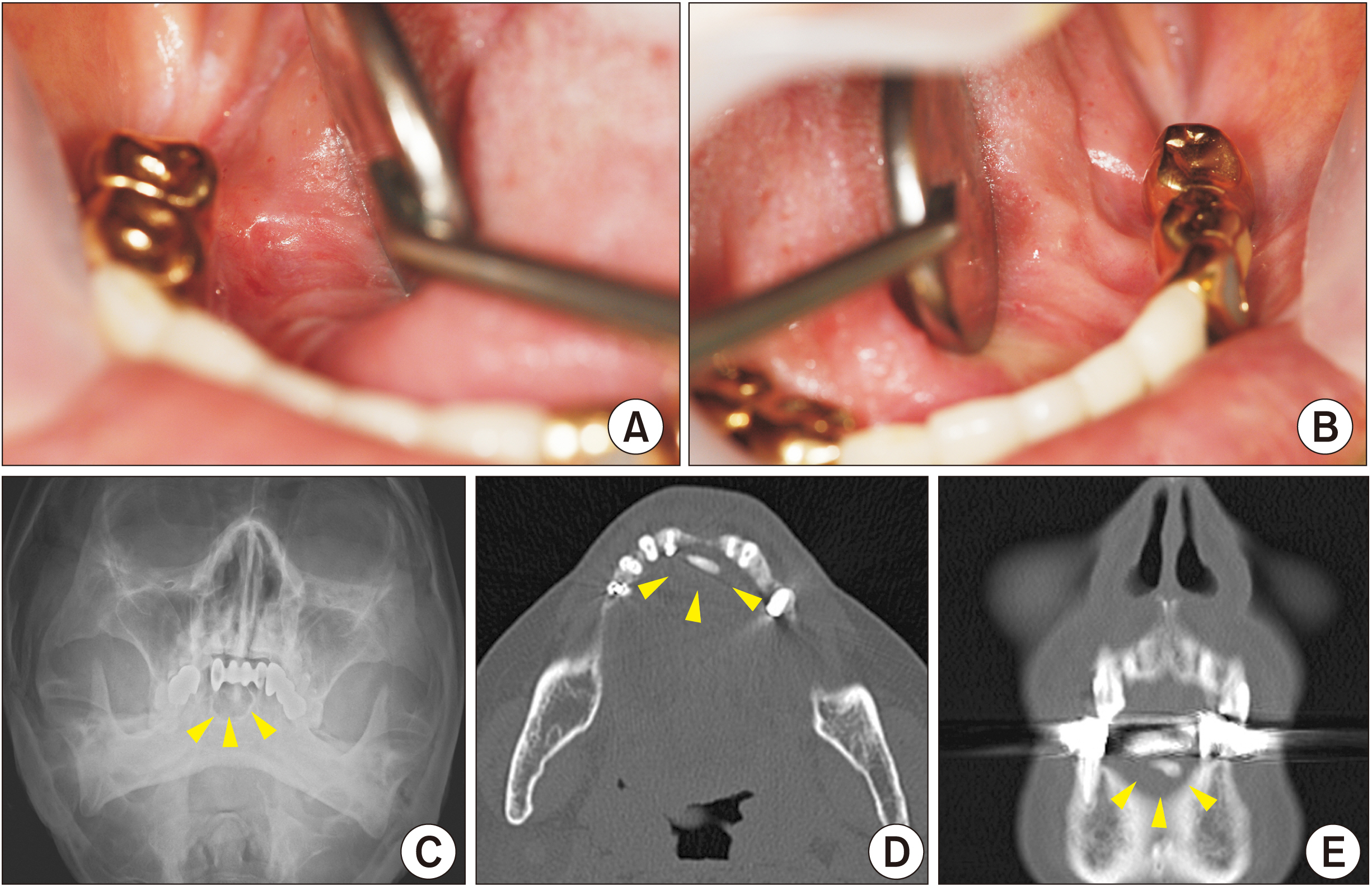J Korean Assoc Oral Maxillofac Surg.
2021 Oct;47(5):394-397. 10.5125/jkaoms.2021.47.5.394.
Acquired synechia of the tongue to the mouth floor
- Affiliations
-
- 1Department of Oral and Maxillofacial Surgery, Dental Research Institute, School of Dentistry, Seoul National University, Seoul, Korea
- KMID: 2521797
- DOI: http://doi.org/10.5125/jkaoms.2021.47.5.394
Abstract
- Sodium hydroxide or caustic soda is a corrosive agent that can cause extensive damage to the oral mucosa, lips, and tongue when ingested either accidentally or intentionally. These injuries include microstomia, shallow vestibule, ankyloglossia, speech impairment, loss of teeth and impairment in facial expression. In the present article, we report a unique case of tongue adhesion to the mouth floor and its surgical management in a 66-year-old female patient, who had a history of caustic soda ingestion.
Figure
Cited by 1 articles
-
Current options in jaw and facial reconstructions
Soung Min Kim, Jong Ho Lee
J Korean Assoc Oral Maxillofac Surg. 2024;50(6):309-325. doi: 10.5125/jkaoms.2024.50.6.309.
Reference
-
References
1. Contini S, Scarpignato C. 2013; Caustic injury of the upper gastrointestinal tract: a comprehensive review. World J Gastroenterol. 19:3918–30. https://doi.org/10.3748/wjg.v19.i25.3918 . DOI: 10.3748/wjg.v19.i25.3918. PMID: 23840136. PMCID: PMC3703178.
Article2. Varkey P, Tan NC, Chen HC. 2006; Corrosive injury of oral cavity--a rare presentation. J Plast Reconstr Aesthet Surg. 59:1110–3. https://doi.org/10.1016/j.bjps.2006.03.069 . DOI: 10.1016/j.bjps.2006.03.069. PMID: 16996438.
Article3. Gupta SK, Rana AS, Gupta D, Jain G, Kalra P. 2011; Unusual presentation of caustic ingestion and its surgical treatment: a case report. J Maxillofac Oral Surg. 10:74–6. https://doi.org/10.1007/s12663-010-0092-x . DOI: 10.1007/s12663-010-0092-x. PMID: 22379326. PMCID: PMC3177500.
Article4. Chidzonga MM. 2021; Microstomia following caustic soda ingestion: report of a case. J Maxillofac Oral Surg. 20:230–3. https://doi.org/10.1007/s12663-019-01247-4 . DOI: 10.1007/s12663-019-01247-4. PMID: 33927490. PMCID: PMC8042083.
Article5. Lupa M, Magne J, Guarisco JL, Amedee R. 2009; Update on the diagnosis and treatment of caustic ingestion. Ochsner J. 9:54–9. PMID: 21603414. PMCID: PMC3096249.6. Ramasamy K, Gumaste VV. 2003; Corrosive ingestion in adults. J Clin Gastroenterol. 37:119–24. https://doi.org/10.1097/00004836-200308000-00005 . DOI: 10.1097/00004836-200308000-00005. PMID: 12869880.
Article7. Ichioka S, Nakatsuka T, Minegishi Y, Asato H, Takato T, Harii K. 2000; Microsurgical reconstruction for caustic injuries of the oral cavity and esophagus. J Reconstr Microsurg. 16:357–61. https://doi.org/10.1055/s-2000-7345 . DOI: 10.1055/s-2000-7345. PMID: 10954316.
Article8. Mamede RC, de Mello Filho FV. 2001; Ingestion of caustic substances and its complications. Sao Paulo Med J. 119:10–5. https://doi.org/10.1590/s1516-31802001000100004 . DOI: 10.1590/s1516-31802001000100004. PMID: 11175619.
Article9. Ryan F, Witherow H, Mirza J, Ayliffe P. 2006; The oral implications of caustic soda ingestion in children. Oral Surg Oral Med Oral Pathol Oral Radiol Endod. 101:29–34. https://doi.org/10.1016/j.tripleo.2005.04.025 . DOI: 10.1016/j.tripleo.2005.04.025. PMID: 16360605.
Article
- Full Text Links
- Actions
-
Cited
- CITED
-
- Close
- Share
- Similar articles
-
- A CASE OF EXPERIENCE OF ARTERIOVENOUS MALFORMATION OF MOUTH FLOOR AND TONGUE
- Lipoma of the Floor of the Mouth: a Case Report
- A clinical study on the anatomical site survival rate in intraoral squamous cell carcinoma
- Removal of a Piercing Bar in the Mouth floor by Fluoroscopy: Report of a Case
- A Case of Alveolar Soft Part Sarcoma in Floor of Mouth Mimicking Ranula




